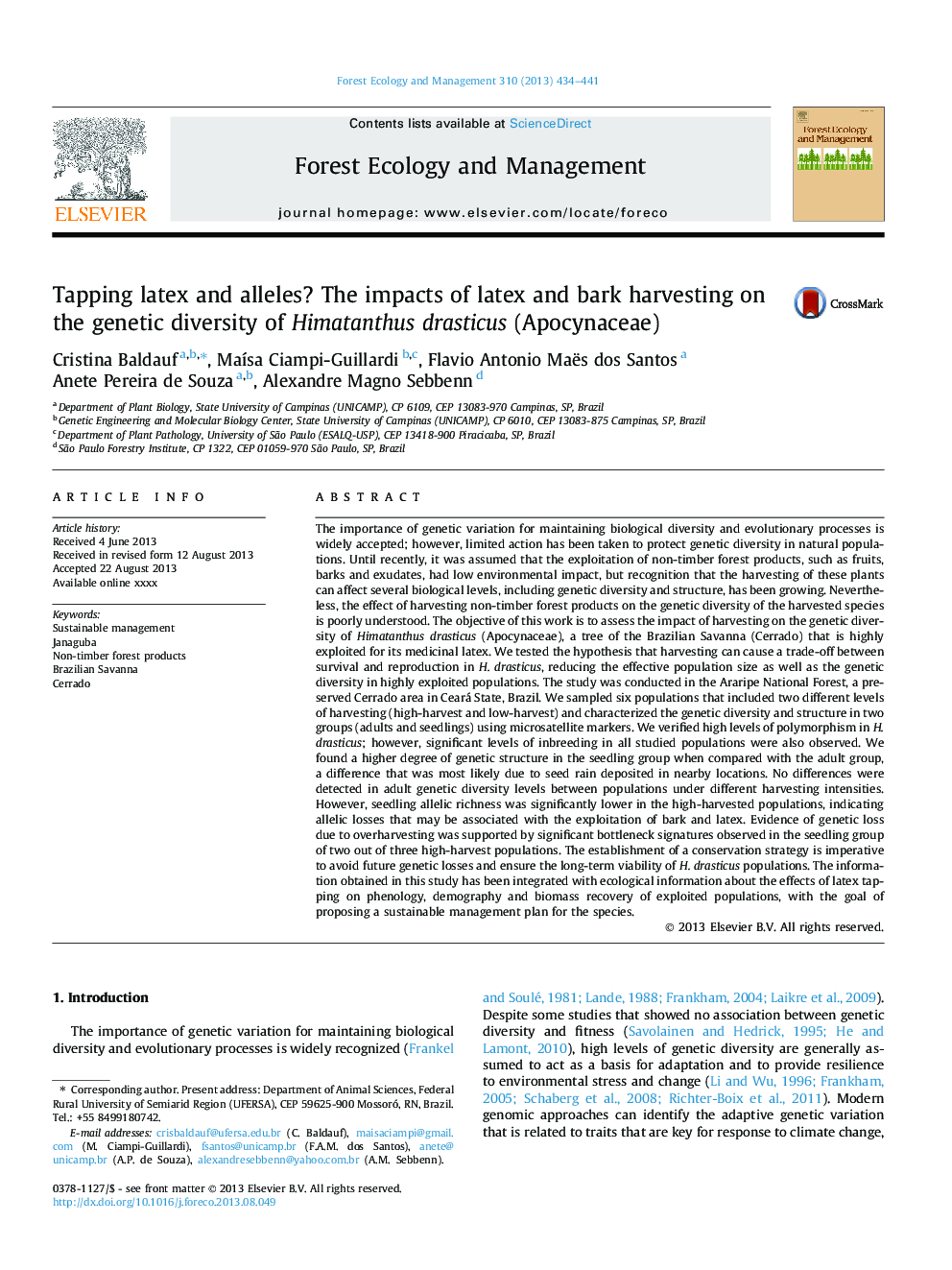| کد مقاله | کد نشریه | سال انتشار | مقاله انگلیسی | نسخه تمام متن |
|---|---|---|---|---|
| 6543743 | 159212 | 2013 | 8 صفحه PDF | دانلود رایگان |
عنوان انگلیسی مقاله ISI
Tapping latex and alleles? The impacts of latex and bark harvesting on the genetic diversity of Himatanthus drasticus (Apocynaceae)
دانلود مقاله + سفارش ترجمه
دانلود مقاله ISI انگلیسی
رایگان برای ایرانیان
کلمات کلیدی
موضوعات مرتبط
علوم زیستی و بیوفناوری
علوم کشاورزی و بیولوژیک
بوم شناسی، تکامل، رفتار و سامانه شناسی
پیش نمایش صفحه اول مقاله

چکیده انگلیسی
The importance of genetic variation for maintaining biological diversity and evolutionary processes is widely accepted; however, limited action has been taken to protect genetic diversity in natural populations. Until recently, it was assumed that the exploitation of non-timber forest products, such as fruits, barks and exudates, had low environmental impact, but recognition that the harvesting of these plants can affect several biological levels, including genetic diversity and structure, has been growing. Nevertheless, the effect of harvesting non-timber forest products on the genetic diversity of the harvested species is poorly understood. The objective of this work is to assess the impact of harvesting on the genetic diversity of Himatanthus drasticus (Apocynaceae), a tree of the Brazilian Savanna (Cerrado) that is highly exploited for its medicinal latex. We tested the hypothesis that harvesting can cause a trade-off between survival and reproduction in H. drasticus, reducing the effective population size as well as the genetic diversity in highly exploited populations. The study was conducted in the Araripe National Forest, a preserved Cerrado area in Ceará State, Brazil. We sampled six populations that included two different levels of harvesting (high-harvest and low-harvest) and characterized the genetic diversity and structure in two groups (adults and seedlings) using microsatellite markers. We verified high levels of polymorphism in H. drasticus; however, significant levels of inbreeding in all studied populations were also observed. We found a higher degree of genetic structure in the seedling group when compared with the adult group, a difference that was most likely due to seed rain deposited in nearby locations. No differences were detected in adult genetic diversity levels between populations under different harvesting intensities. However, seedling allelic richness was significantly lower in the high-harvested populations, indicating allelic losses that may be associated with the exploitation of bark and latex. Evidence of genetic loss due to overharvesting was supported by significant bottleneck signatures observed in the seedling group of two out of three high-harvest populations. The establishment of a conservation strategy is imperative to avoid future genetic losses and ensure the long-term viability of H. drasticus populations. The information obtained in this study has been integrated with ecological information about the effects of latex tapping on phenology, demography and biomass recovery of exploited populations, with the goal of proposing a sustainable management plan for the species.
ناشر
Database: Elsevier - ScienceDirect (ساینس دایرکت)
Journal: Forest Ecology and Management - Volume 310, 15 December 2013, Pages 434-441
Journal: Forest Ecology and Management - Volume 310, 15 December 2013, Pages 434-441
نویسندگان
Cristina Baldauf, MaÃsa Ciampi-Guillardi, Flavio Antonio Maës dos Santos, Anete Pereira de Souza, Alexandre Magno Sebbenn,